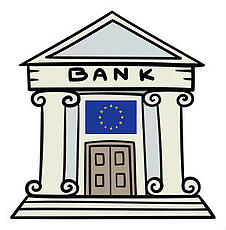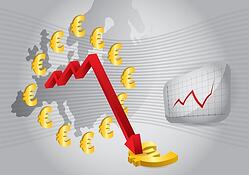 Our European (EU) Quantitative Easing (QE) overview. It’s big EU news. It’s official. It's just in time central banking. EU QE phew-ee. On Thursday the 23rd January 2015, Mario Draghi (we call him Super Mario) our European Central Bank (ECB) President, announced the EU’s >€1 Tn government bond buying program. The ECB is noted as the last major central bank to embark upon such a program. US QE dates from 2008, and that of the UK from 2009, and both are deemed to have worked. So questions abound for the EU. Is it too little, too late and will the twin objectives of spurring economic growth (recently revised down to 1.1% for 2015) and halting the deflationary slide (inflation at <1%, and heading down) be achieved?
Our European (EU) Quantitative Easing (QE) overview. It’s big EU news. It’s official. It's just in time central banking. EU QE phew-ee. On Thursday the 23rd January 2015, Mario Draghi (we call him Super Mario) our European Central Bank (ECB) President, announced the EU’s >€1 Tn government bond buying program. The ECB is noted as the last major central bank to embark upon such a program. US QE dates from 2008, and that of the UK from 2009, and both are deemed to have worked. So questions abound for the EU. Is it too little, too late and will the twin objectives of spurring economic growth (recently revised down to 1.1% for 2015) and halting the deflationary slide (inflation at <1%, and heading down) be achieved?
EU Quantitative Easing details
Firstly let’s look at the amount: €60 Bn (>$70 Bn) of mostly government bond purchases per month. This adds up to >€1.1 Tn, raising Eurozone broad money supply to >6.5% per annum in line with US QE. Now the duration: the start is 03.2015 and will continue until 09.2016. That said, the message was open ended as Super Mario stated he would continue until he “sees a sustained adjustment in the path of inflation.” Confused? Everyone is. Comments abound that this is not enough (should be >€2 Tn) and too spread out (>18 months), as worried Eurozone central bankers claim that the EU needs the blunderbuss (EU 19th century terminology) or bazooka (US 20th century terminology) approach, as deployed by Japan (in the 21st century). Now the final trick is that normal ECB action is (by definition) pooled, among the 19 nations comprising the Eurozone. However, due to pressure from powerful sources, read Germany, EU QE takes an unusual form in that the 19 nations will each take majority (80%) responsibility for any losses on their own sovereign debt. Not very, one for all and all for one, eurozone that! But, can you think of any way to get the Germans to shoulder Greek, Italian, French and the list goes on, debts?
The two EU Quantitative Easing views
The ECB has a 6 person Executive Board that runs the bank, managing day to day issues and then a 19 strong Governing Council, representing each of the Eurozone states. It is common knowledge that ECB Board and Council meetings have become increasingly fractious; dissent is now publicly aired and QE is the most divisive subject.
The majority of the 19 Eurozone countries, especially those in the periphery and the south, need and hence want QE. There is a lot of “Oui” and “Si….”. French President Hollande and his Italian counterpart Prime Minister Renzi, lead this camp. Numerically, they dominate the ECB Executive Board and the Governing Council.
However, there is a determined “Nein, danke!” The German Chancellor, Angela Merkel, is on record saying that QE is a “very, very bad thing”. Strong words, whispered to UK Prime Minister Cameron whilst Merkel was in London at the British Museum, visiting the utterly brilliant exhibition “Germany: Memories of a Nation, a 600-year history in objects.” Sorry if you missed that. Germany is opposed to EU QE, which is one of the main reasons the program commenced only now, 6 years after that of the US! Germany could no longer stop it, but tweaked the program into devolved national responsibility. Why are they so anti-QE and demanding of national responsibility? The reason is relatively simple. The German Central Bank’s (Bundesbank) President put it succinctly by stating, “It’s clear that the [bond] buying will reduce the pressure — on countries such as Italy and France.” The pressure he is talking about is that to implement tough economic reforms, and fundamentally that means working harder, being paid less and being less dependent upon the state. Germans view QE without policy (structural, fiscal, banking, labor…) change as a wasted (last?) opportunity for the Eurozone.
The Euro is down

By >8% against the US$, since the start of 2015! Losing >4% against the US$ in just 2 days, as QE was announced. As I write, the € seems to have bottomed out against the US$ at an 11 year low, valued at US$1.111. Looking forward, expectations are of US$1.1 imminently and parity (only another 10% to go), before 2015 is over. Parity is clearly the objective of some Eurozone politicians, notably Italian Prime Minister Renzi, who whilst in Davos last week for the World Economic Forum (WEF), clearly had trouble sleeping as he stated that he “dreams of parity.” From a US$ perspective, the € fall means that the US$ trading basket of currencies index hit its strongest level in 12 years. Moreover, as the US economy continues to recover, the Federal Reserve will increase interest rates supporting the underlying strength of the US$. Renzi should sleep better.
EU equities are up
And by a healthy >7.5% so far in 2015! These are turbulent times. The Euro Stoxx 50 (our Eurozone blue chips) was up by 2.3% on announcement day alone. Business likes QE; essentially as central banks buy bonds, money goes elsewhere so funding costs are reduced. Overall, this is good news for EU businesses, and within that big +ve picture let’s focus upon growth sectors. Benefiting directly from QE are those sectors that are capital intensive (borrowing costs down) on one side and have consumers (more money in the pocket) on the other, including automotive, chemical, construction, mining and pharmaceuticals.
Will QE work?
Spurring economic activity for the ECB, means a Eurozone average >2% GDP growth. To hit this number, the big 3 Eurozone countries, Germany, France and Italy, must lift their 2015 GDP growth numbers up from their current projected 1.1%, 0.6% and 0.5% respectively. Germany, export driven, but hampered by their international markets lack of growth, nevertheless look good for 2016. When Super Mario talks of the “path of inflation”, the guideline goal is, guess what, 2%. The recent collapse of oil prices, has compounded deflationary pressures in Europe, we are the world’s energy largest importer, but that will work its way through within 12 months. This QE story rests with the performance of France and Italy, and the jury is out.
